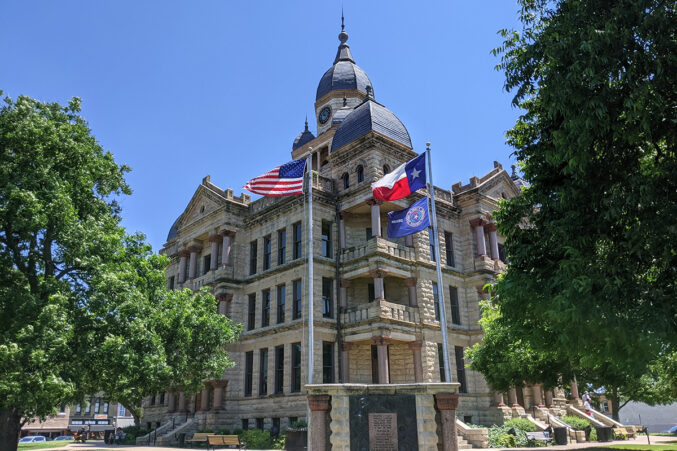Last night, I was fortunate enough to be asked by D Magazine to participate on a panel regarding the Arts District, and more specifically, how to improve it. Before I get into it, I also want to say it was great to meet the various blog readers that showed up. Really enjoyed meeting all of you and glad you could take part in the Q and A.
Along with Deedie Rose, board member of the AT&T Performing Arts Center, Charles Santos, TITAS artistic director, and Veletta Lill, former Dallas City Council member and current exec. director of the Dallas Arts District, I was the only urban planner and most likely the only one expected to hurl objective criticism the way of the Arts District.
Somewhat fearing that and consciously aware of not hogging all the airtime, I tried to walk a fine between criticism and suggestions, analysis of it as it exists and comparisons to other arts districts. Because of that, I felt like everything I said must be distilled into talking points and/or soundbites, which is the genesis of this post where I want to take the time to fully discuss the Arts Districts and the points I was trying to make without boring everybody with talk of artisan guilds in the medieval ages (I’ll get there – so tune out if you don’t want to hear/read it).
I have been known to be hard on the Arts District in the past, but consider it out of love. I love Dallas, living in Dallas, the opportunity it presents to mold it, and the ambition of its residents. So, as a Dallas resident, with a deep understanding of how cities work, evolve, and are shaped, I also want Dallas to be the best it can be, without joining the army.
I often personify cities allegorically to help translate what can come off as gibberish. Similarly, I am a big believer that radical honesty is the first necessary step in self-improvement. With that I want to first offer proper background and analysis of the Dallas Arts District (from hereon referred to as DAD – paternalistic/ironic/I like it) and ideas for its forward evolution.
First, the DAD is an entirely new animal as far as Arts Districts go. My guess is that most people conceptualize arts districts they are thinking of funky areas where artists agglomerate and transform into hip areas. That is not an incorrect assumption. In fact, that is pretty much how all arts districts have been formed, informally. Only later have some become formalized, with an official organization forming to brand, market, and program events. This stabilizes arts districts and allows them to fend off gentrification (typically).
This process can be traced (through written records) back to the artisan/trade/craftsmen guilds of the medieval ages, where similar professions clustered for competitive advantage. They did so to 1) organize, 2) share trade secrets and innovations in technique/material, 3) occasionally price fix, and 4) fend off newcomers. I’m not judging on any of those, it’s just the way it was. They were humans and we still deal with similar impulses to this day. Funny lot, we are.
They also did so for marketing awareness. There was no google maps or iphones to look up where the nearest blacksmith was. But, there was a precinct where you could go and walk down the street and compare quality of craft, price, etc. And it was well known what streets/blocks/neighborhoods you would go to to find certain goods. When times were good, the guilds would build grand market halls or masonic temples, etc. harkening back to the quasi-religious roots. These became the centerpieces of their professional “arts” district, anchoring the character of the neighborhood for as long as the trade still found a market (you don’t find many blacksmiths around these days).
A modern version of this, might be the Kansas City arts district, the Crossroads. It evolved informally, eventually became an institution putting down roots, and now the city of Kansas City decided to put a “cherry” on top of this neighborhood with the new Kauffman Performing Arts Center.

I’ll let you debate whether the design and/or scale fits with the area as that is not of relevance to the rest of my post/analysis.
The other form of an arts district is the more ephemeral. The one that rejects institutionalization, whether consciously or unconsciously. Like the previous version, artists cluster in areas ONLY because of where it is cheap, but facilitates clustering, i.e. the suburbs are cheap, but not in the least bit interesting. Too underscore this point, there is a vibrant art scene out in historic West Texas towns, cheap, historic, fabric facilitates clustering. I believe artists intuitively search for soul in where they locate.
New York City is my favorite example of this. Artists and other creative types are constantly packing up shop and moving to a new down-trodden area, often because they have either been priced out of an area or that it lost its soul due to the nerve gas of gentrification. Keep in mind, that when I refer to gentrification, I don’t mind the rising prices as product of rising demand, but I do object to an area being over-run by chains, hence losing its soul.
Think about how many times a new area of New York becomes the hip spot. It’s almost like clockwork, every five years. If you haven’t visited NYC in five years, you’re likely to go to SoHo or Meatpacking district thinking they’re still the cool spots, only to find those that made it hip have moved on.
Look at DUMBO in Brooklyn now. A dreadful piece of property under two bridges. Creative types, digital artists, found cheap space, made it cool by focusing their creative energies like a magnifying glass to the sun on it, and reshaping the neighborhood. Artists/Creative types are our worker bees or explorer ants searching out new patches of honey to build nests upon.
I also think they reject areas the moment they lose their counter culture status, which presents a challenge when institutionalizing an area or putting down roots to a particular location. What do we lose when locating them in one spot, hindering their ability to qualitatively uplift various parts of the city and make them more livable, interesting every generation (or more frequently). More on this in a bit.
I discuss all of that so that I can point out that the Dallas Arts District was created more by a stroke of a pen than from the grassroots. It has been completely top down and as long as we recognize that, and the inherent strengths and weaknesses from the process, it is ok.
When you eschew the grassroots evolution of places, by imposing a “district” on an area rather than cultivating the positive evolution, you are essentially jumping the gun. You are immediately putting yourself in a position to subsidize it for a very long time. It’s a premature baby that needs an incubator.
So we have to build all of the facilities more or less through charity on land donated by the city knowing full well the taxes generated on pricey downtown land will be minimal at best (compared to other downtown forms of development). Then we need a Dallas Arts District, under the very capable hands of Veletta Lill, to nurse the thing to life.
Since it essentially popped out of the ground overnight (in the lifespan of cities rather than people) rather than building organically, and as I stated last night, it is much closer to a World’s Fair site than a true Arts District. This is why I compared it to Balboa Park in San Diego last night and also why we probably need to recalibrate our expectations of it.
Can it ever be a vibrant, funky neighborhood like Ray Street in San Diego? Highly doubtful. But it can be closer to a modern version of Balboa Park, which was not a World’s Fair, but a Pan-American Fair. Might as well be the same thing for our discussion.


What we have to understand, is that the DAD is more like a World’s Fair than what we understand to be arts districts, hearkening all the way back to artisan districts, because those were part of real neighborhoods. The “arts” component wasn’t the primary use. The neighborhood residences still were, as in any real neighborhood. Arts, of various sorts, just so happened to be the preeminent “storefront” use, or secondary use, differentiating it from any other neighborhood and its character.
Like a World’s Fair, there is very little actual neighborhood component. In fact, the DAD almost has it backwards if we’re trying to describe it as a neighborhood. The residential claims priority, One Arts Plaza, as the tallest building and terminating the axis. To accentuate this inside out nature, its iconic location is contradicted with a very sterile, “blank canvas” sort of design. The “objects” become the fabric. The more is less, the less is more.
This means that all of those performing arts centers have effectively squelched out any available space to really link other uses directly into it, unless we start calling Ross as the primary spine of a “bigger” arts district, as Veletta alluded to when she started calling the vacant (surface parking) land south of Ross as “Arts District South.” Until that land is incorporated, providing many of the other uses that comprise complete neighborhoods, we have a DAD with lots of punctuation points and little prose, i.e. no syntax. We’re not making complete sentences, and perhaps not even sense.
Balboa Park, the primary arts/cultural component was built in 1915 in the middle of protected land that functions very much like San Diego’s version of Central Park, rugged, natural terrain, with moments of formality and people space set within a dense grid of streets and blocks. The Arts and Cultural area is also set on a spine, like Flora is for the DAD, with ornate buildings flanking both sides. BP is designed in the Beaux Arts style whereas DAD is more modern (duh). Again, nothing wrong with that.
They are both more drive-to/by/thru destinations, but the DAD probably has more potential to better participate with its downtown. With that said, BP is very highly utilized with or without programming, just as a place to breathe, exercise, and be, a Central Park.
Where BP succeeds and DAD is lacking is in its outdoor spaces and organization. Beaux Arts designers paid specific attention to the hierarchies of spaces where modern designers tend to forget?/eschew?/ignore?/if not destroy outright in order to create a sense of disarray, disorder, disorientation, or confusion. Apparently fun house architecture is in these days. Sideways eyes at you Rem, REX, and Libeskind. Totally off subject, but if your intention is to disorient and make uncomfortable, you should lose your commission if not license. It works in holocaust museums, not in regular museums. See Denver Art Museum, also known as “DAM, we effed that one up.”
The opening question asked last night was, “is the DAD too big?” Very open ended, which I responded that in terms of land area it is not, as most organic arts districts are considerably more vast. In relation to the human scale and how we understand, perceive and navigate space, it is both overwhelming and disorienting, if you understand space syntax, which intends to objectify this human perception of scale, space, and movement within space. Despite being organized around a central axis (Flora) with strong terminating presences (One Arts and DMA), there is a lack of order to Flora and its sub-spaces. In fact, the sub-spaces are for the most part imperceptable.
Given the size and scale of the facilities in DAD, I think there is a real opportunity to introduce a fine-grain component of both outdoor spaces, walks, pocket parks, that feel like real pocket parks, that are lined with usable space. My idea last night was a series of movable shipping containers, designed to be cool artist gallery/work space to create a real window shopping type of presence and more day/night activity when there are no ticketed performances. These would be intermingled with the food trucks to create a food court type of presence during typical meal hours/special events.
The beauty of these is that 1) they can be rearranged every few months or so, or during special events to provide a constantly evolving/changing/more interesting experience for visitors. Furthermore, these can be market-rated and initiated with micro-leases and very cheap rent until momentum builds and somebody wants to come along and sign a longer lease.
That is one potential idea to bring more order to the undifferentiated, undefined green space that dominates the DAD. Perhaps its biggest challenge though is bridging the gap between institutional and counter culture as alluded to earlier in this piece and as I did last night. Somebody asked how do get students there and the types of bands that students want to see to play there. I suggested that currently the Arts District acts as a hub or port, importing culture from afar and bringing it to Dallas, a good thing.
However, we have so much talent here, that it also provides an opportunity to showcase local talent and export some of it to the rest of the world, a grander stage. Local talent is and always will be more “Dallas” than any top down arts district, and frankly, we have to accept that. There may be plans to do so, but as one artist came up and told me afterwards, “I’m tired of plans.” Me too, dude.
The question becomes, how do you make the institutional and possibly psychologically exclusive palatable to an industry that prefers the counter culture, the underground, that which is NOT accepted by the establishment, in many ways the raison d’etre for the arts?
I can talk forever about urban form and improved connections (and the physical and economic advantages of tearing out freeways), but if you can answer that question, then we will be that much further along answering the deeper psychological barriers to the success of the DAD.







